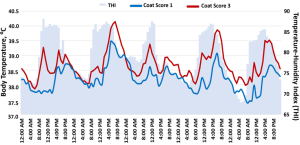By Dr. Raluca Mateescu, Professor
Importance of heat stress
Heat stress is a major cause of economic loss for beef cattle producers in tropical and subtropical environments, including Florida. Bos indicus genetics are commonly introduced into beef cattle herds in these areas, as they are better adapted to hot and humid conditions. This practice has improved the heat adaptability in the crossbred herds. Identification of animals with the ability to regulate body temperature in hot and humid environments, while still maintaining high performance for important production traits will hold the key to future success for cattle production in harsh environments. Hair type, sweating rate and temperament are among the factors affecting the ability of animals to maintain their body temperature within normal physiological limits in environmental conditions with high heat stress potential.
Hair Coat
One important factor influencing the ability of a cow to remove heat from the body is the type of hair the animal has. Hair insulates the body by trapping air next to the skin, making convection less efficient by not allowing air to flow over the skin surface. More importantly, long and thick hair traps sweat. Sweat trapped in hair cannot evaporate as easily, leaving the animal with the heat contained in the sweat. Coat color also plays an important role with lighter color animals absorbing less heat than dark-colored animals, allowing them to remain cooler throughout the day.
Current research on Florida beef cattle
Our research group in the Department of Animals Sciences at the University of Florida is working towards developing selection strategies to improve heat tolerance, while conserving the high production, reproduction, and quality traits we are striving for in the beef cattle industry. Hair coat is one of the many factors we are examining in great detail. Length and thickness of hair varies considerably not only between breeds but also within breeds. This variation suggests that selection for a coat advantageous for improved thermotolerance in our cattle is possible. We recorded hair coat scores and daily body temperatures at 5-min intervals over a 5-day period on thousands of Brangus heifers from the Seminole Tribe of Florida and the Williamson Cattle Company during the summer since 2016.
The coat was scored (Figure 1) as excessively smooth (score 1), fairly smooth (score 2), long coat (score 3), or wooly (score 4). The coat score had a significant effect on body temperature, where cows with excessively smooth coat had lower body temperatures throughout the 5 days of continuous body temperature measurements (Figure 2) indicating that coat type plays an important role in the control of body temperature. A slick dense coat provides a greater resistance to heat transfer to the skin and therefore reduces the heat gain from the environment when the animals is in sunlight. A smooth coat can minimize heat gained from the sun by providing greater resistance to heat transfer to the skin. Additionally, a long, wooly coat minimizes conductive heat exchange and traps sweat interfering with an efficient evaporation process. High level of variation in vaginal temperature in a population of same age Brangus heifers, managed uniformly and measured under similar environmental conditions is indicative of selective improvement opportunities. These findings could be useful for producers trying to improve the thermotolerance in their herds by implying that selecting cattle with shorter hair coats could help increase thermotolerance.


Find more information about the UF/IFAS Department of Animal Sciences events on our website. Stay in touch with us on Facebook, Twitter, and Instagram. Any questions or inquiries regarding this piece should be directed toward Dr. Raluca Mateescu at raluca@ufl.edu. Read more stories like this one here: http://blogs.ifas.ufl.edu/animalsciencesdept/.
 0
0
